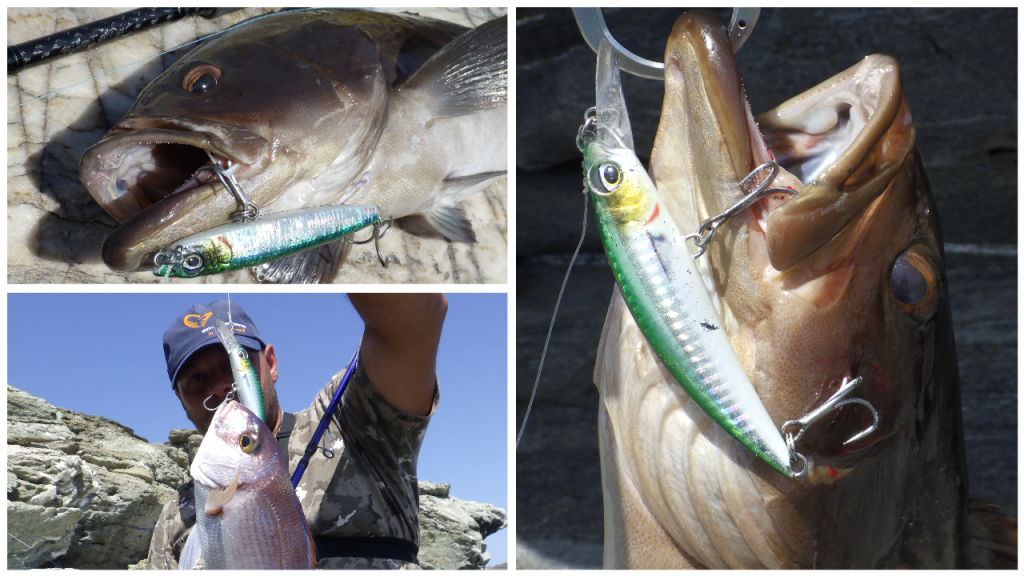Bottom Predators in mid waters! Myth or Reality?


It is a common belief that if you want to get your hands on a big fat badass grouper species or feel the ferocity of the strike of a fierce snapper, you need to animate your lure “one breath” from the hostile bottom that these fish prefer! On a glance, this might seem real, and on some occasions might be the only way, but is it the rule? Absolutely not!
How many lures I need to lose so I can get the desired fish?
Honestly, I wish I could tell you none, but as the omelet needs some broken eggs, same goes for the bottom species! So if you do not want to risk your lure, then bottom species are not the ones you should go after, and your demands should be limited to pelagic and surface species. But there is a big BUT!
The BUT! (Not Butt)
Eventually the wheel goes round and there are sometimes that fish are really active (due to weather or environmental conditions) and they often decide to leave the bottom to strike even as high as 10+ meters above it. Barometric pressure, wind conditions or prey species, (groupers and snappers are used to attack in mid waters to get sardines or bogues that mainly stay there) are good reasons for a bottom predator to make a fast attack on the mid waters. This gives us a chance to be victorious and with a very high potential of success. Why? Because half of the job is already done, and the fish is already away from the bottom. Especially bottom predators know how to use the rocks as a tool to get free from the line, and it will be very hard for them to manage to get so many meters to reach the bottom. (Unless you forgot to have the appropriate pre drag setting you silly boy)! Other reasons that make the bottom fish to raid the mid waters are the waves and rain. Both conditions make the waters muddy or milky cloudy for different reasons, but the result is that bottom fishes take advantage of this camouflaging situation, to get easier the mid water delicacies!

Depth and strike zones
While a snapper or a grouper could easily attack a lure in the standard 3m distance from the bottom, it would seriously consider if it would attach higher than this, if the conditions are not the ideal. There is no reason a grouper/ snapper to expose itself unnecessarily to bigger predators (seals for example) and even with the appropriate conditions, they will limit their attack in a certain level. This lever almost always is the same and usually is 10-15 meters from the bottom. Having said that, we can expect in a total depth of 50 meters to get a strike at 35m depth from the surface! It is not that bad right? It is easy to keep animating your lure there with minimal snagging threats! But you should also consider that the same range level is the same for the 30m where the strike zone could be as high as 15m from the surface, and so would be in 20m/5m from the surface and/or to depth from 15 and shallower is not a surprise to see a grouper or a snapper even on a top water lure. But why these 15 meters are such a solid rule? These species do relay for their buoyancy on their air bladder. This air bladder always has an amount of air that expand or shrink depending on the depth. The deeper they are, the most pressured the air is inside them. And now the impressive part. The law of the 15 meters seriously decreases in deeper waters and a snapper that is at 100 meters, would have a harder time raiding the 75 meters, since this don’t give the time to the air bladder to adjust to the huge pressure difference. However in 15 meters is very possible, since the pressure is less, and as you might correctly suspect, in a 20m of depth a fish could attack on the surface if it wanted to. But I will come back for the air bladder and how we can take advantage of it, on our fight on another article. So better stay tuned!
Strike zone and species.
While we can expect from a gold blotched grouper to leave the bottom and attack as high as 15 meters, we definitely don’t expect from a dusky grouper to do so! White groupers are also very capable to reach same levels as gold blotched groupers, and mottled groupers can surpass them all and reach easily even higher levels. Snappers are a subject of the 15m range. The reason that these fish are able to reach different levels, is due to their speed ability to adjust their air bladders and nothing more. But as I said, wait for the next article very soon! 💪💪💪










